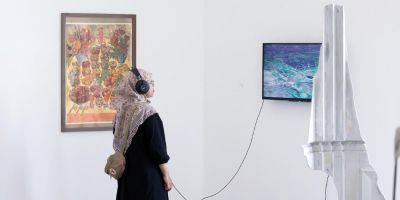Our Wider Flesh exhibition showcases work by postgraduate researcher Clare Carter

A new exhibition of ceramics, installation, projection and video by practice-based postgraduate researcher Clare Carter opens this week in our Project Space.
Our Wider Flesh charts the first year of artist Clare Carter’s practice-based PhD project ‘Mothering Beyond the Flesh’ which investigates the relationships between landscape, maternal agency and creative practice.
Situated in the post-industrial and semi-rural landscape of West Yorkshire – where the artist was born, raised and currently lives with her two young children – the first year of Clare’s research has focussed on uncovering the historical and theoretical roots of her own separation from this landscape.
It addresses how maternal and creative practice can generate narratives that might illuminate ways in which to attend and re-attach ourselves to the immediate environment.

Screenshot from Clare Carter’s video ‘Our Wider Flesh’ (2024). Image courtesy of the artist.
Clare Carter is a multi-disciplinary artist and researcher with a history of song writing, music composition and performance. Her practice is auto-ethnographic and engages with site-specific projects that explore the human attachment to landscape and notions of world-making.
Carter finished her MA Fine Art in September 2022 at the University of Leeds, when her work was showcased at the degree show (hidden) alongside five other graduating artists.
She was awarded a White Rose College of the Arts & Humanities (WRoCAH) doctoral training scholarship for her PhD research project in the School of Fine Art, History of Art & Cultural Studies in 2023.

Clare Carter, Ceramic sculpture from the Guaguas series, 2024. Fired clay vessel with mine ochre slip and glaze.
Clare Carter said:
“Our Wider Flesh takes its name from an essay written by cultural ecologist David Abram, who describes the journeys of migratory animals such as the Monarch Butterfly and Sockeye Salmon through the sensory exchange that guides them across the surface of the Earth to reproduce.
“These animals navigate thousands of miles over land, through the ocean and along rivers to exact locations with no ‘internal map’ or representational image projected outwards onto the world, guiding them to their destination. Instead, it is performed through the sensations of the landscape experienced through their bodies. As Abram suggests, the landscape becomes part of their wider flesh.
“Through the lens of motherhood, the eponymous video in this exhibition articulates ideas about bodies and land, maternal ancestry and the enclosure acts preceding the Industrial Revolution in the West that enabled capitalism to flourish across the world.

Screenshot from Clare Carter’s video ‘Our Wider Flesh’ (2024). Image courtesy of the artist.
“Set around a building site in a field across from my terraced house in the semi-rural, post-industrial village of Denby Dale, West Yorkshire, an a capella composition emerges from responding to the sounds of diggers and machinery as the landscape is carved up and turned into future homes.
“Footage I have taken through moving through this landscape is projected onto paper using a faulty projector that is in the process of breaking down – metamorphosing and composting the imagery as it moves across the surface.
“My seven year old child is projected dancing around the arches of the Victorian viaduct next to our home. The video weaves her body into the space, mirroring and reifying the sensory exchange that might have existed before people were separated from their land throughout the centuries of capitalism.
“This separation can be witnessed and experienced as the dualisms of nature and culture manifest within the landscape and ecological crisis that is currently unfolding in the Anthropocene.”

Detail from video by Clare Carter. Image courtesy of the artist.
In addition to the video ‘Our Wider Flesh’, the exhibition presents a series of ceramic works made with materials foraged from the mines and fields close to the artist’s home, responding to the flesh of the land through intimate and performative vessels and tiles.
Other works-in-progress include installation with projections, alternative photographic processes and auto-ethnographic writing.
Engaging with maternal, phenomenological, ecofeminist and landscape theory, the works on display are meditations on placemaking, geological deep-time intimacy and the cyclical nature of dwelling and caregiving – becoming research artefacts that trace the convergence of these different practices.

Clare Carter, Ceramic sculpture from the Guaguas series, 2024. Fired clay vessel with mine ochre slip and glaze.
Dr Anna Douglas, Lecturer in the School of Fine Art, History of Art and Cultural Studies and one of Clare’s PhD supervisors, said:
“Through her daily walking the boundary of her home, Clare maps familiar territory.
“What commenced as a mindful routine during Covid has evolved into an artistic practice of landscape investigation, in which she reflects deeply on its embodied and psychological effect.
“Motherhood, family inheritance and memory are entangled and explored through manipulating the materials of the land; local river bed clay with its ex-mining minerals form the basis of a series of light-based projections.”
More information
Our Wider Flesh runs from 3 to 6 July in Project Space, located in the School of Fine Art, History of Art and Cultural Studies at the University of Leeds.
The exhibition is open Wednesday to Friday from 11am to 4pm, and from 11am to 2pm on Saturday. Entry is free and all are welcome.
Full details about Our Wider Flesh can be found here.
Find out about Clare Carter’s research and art practice.
Feature image
Screenshot from Clare Carter’s video ‘Our Wider Flesh’ (2024). Image courtesy of the artist.




